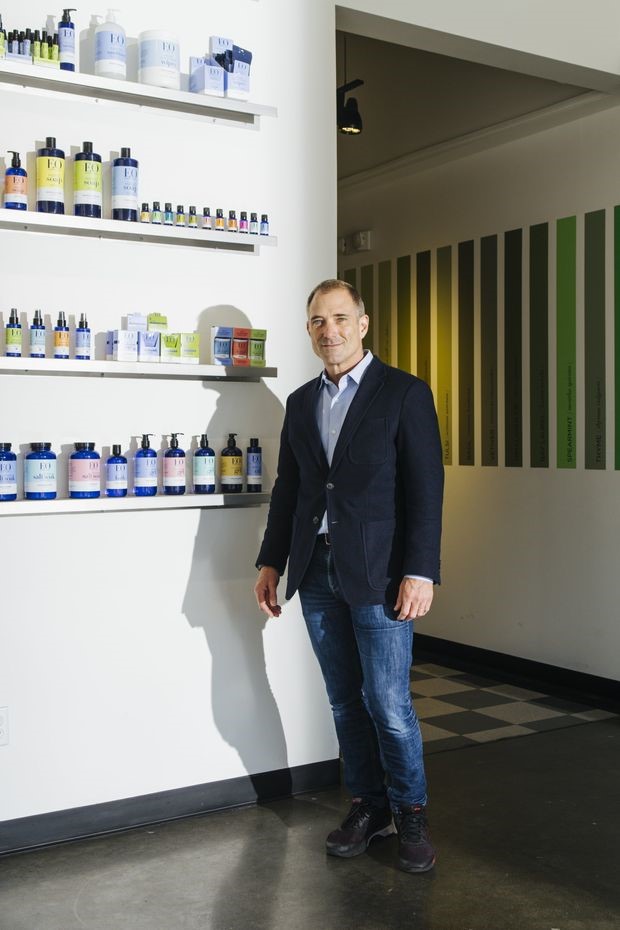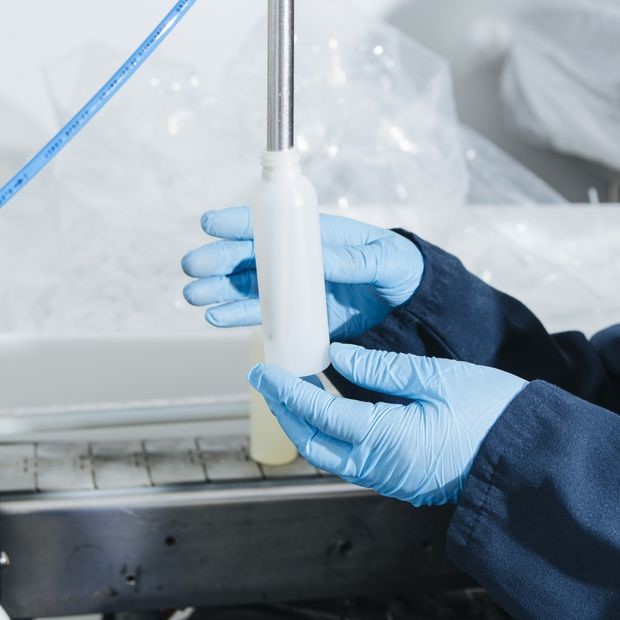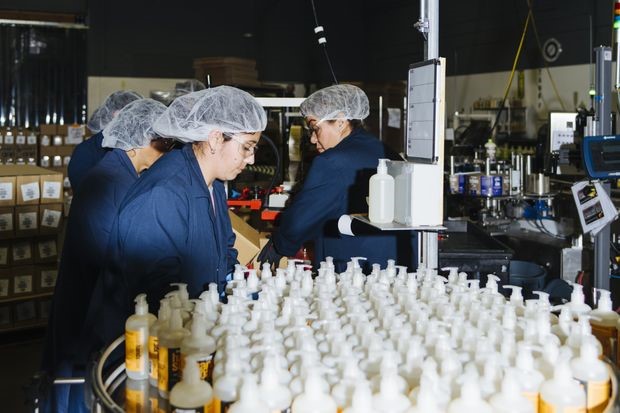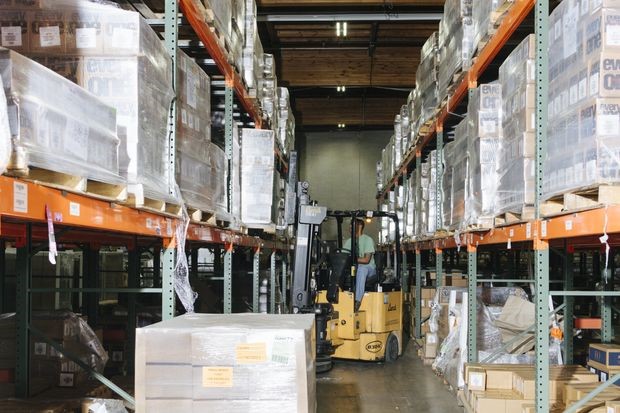San Rafael, Calif.—EO Products, a Bay Area maker of bath and body products, has quadrupled production of its high-end hand sanitizer. It is running extra shifts, speeding up lines, hiring temporary workers and converting factory lines designed for other products to make hand sanitizer instead.
It still can’t keep up.
Customers call, sometimes in tears, begging for a few bottles they say they need to care for sick relatives. Retailers, facing an unprecedented surge in demand, are rationing as they try to restock bare shelves. A parts shortage with no workaround almost halted production on the factory floor.
“How do you prepare for a huge spike in demand where everything sells out and everyone is mad,” said EO Products President Tom Feegel. “You don’t prepare for that.”

‘All the business rules about profitability are off the table,’ says EO Products President Tom Feegel. Source: Cayce Clifford, The Wall Street Journal
A once-sleepy staple, hand-sanitizing products—wipes, sprays and gels—are selling out nationwide in the time of coronavirus, as health officials say disinfecting hands and surfaces is critical to stopping the contagion’s spread.
At one point last month, one of the company’s suppliers ran out of the aluminum-like seals that go on hand-sanitizer gel bottles and are roughly the size of the tip of a pinkie finger. Federal regulations require stringent testing of any replacement seal, so there was no quick answer.
“It was a horrible feeling,” Chief Operating Officer Sam Borri said of the moment he realized the company was going to run out. “My immediate reaction was, ‘How can this be happening?’ ” The company had to stop making gel sanitizer for a time, while upping production of sanitizing spray.
Sales ramped up dramatically at the beginning of March, and the company expects that trajectory to continue as the virus affects more parts of the country.
No manufacturer has been able to make enough—not even Purell, the top U.S. brand by sales. Purell parent company Gojo Industries Inc. is rationing sales to stores to protect supply for hospitals and other businesses. Private-label brands are likewise selling out.
Gojo said it is working to further increase capacity for Purell. “Consumers are buying out these products as soon as they hit shelves, which is amplifying the sense of shortage,” the company’s CEO, Carey Jaros, said in a statement.
Amazon.com Inc. and eBay Inc. are fighting price-gouging by third-party sellers. Meantime, the state of New York has prison inmates making sanitizer to bolster supply.

EO Products employees are working extra shifts to help increase production of hand sanitizer and soap. Source: Cayce Clifford, The Wall Street Journal
U.S. hand-sanitizer sales were just below $200 million in 2019, a 4.5% decline from the previous year, according to Nielsen. The most recent data available shows U.S. hand-sanitizer sales were up more than 470% for the week ended March 7, compared with the year-earlier period.
At a nondescript complex about 20 miles south of San Francisco, EO Products develops, produces and packages its Everyone brand of fragrant, organic soaps, lotions and sanitizers alongside its higher-priced Essential Oils line of body-care products. A six-pack of 2-ounce Everyone hand-sanitizing gel bottles costs $17.99, or $1.50 an ounce, roughly 50% more than a similar-size package of Purell.
Hand sanitizer generally is made mostly of alcohol. The Centers for Disease Control and Prevention says sanitizer should contain at least 60% alcohol to be effective. The company has also ramped up production of soap as the CDC recommends washing with soap and water, when available, over using hand sanitizer.
The company, with about 150 employees, sells the bulk of its products at retailers. It has been at Whole Foods for more than 20 years and has more recently started selling at Walmart, Target and Amazon. Before coronavirus, the company was doing roughly $100 million a year in sales. Owned by its founders, a divorced couple that still work together, the 25-year-old company is privately held and has no outside investors
Neither hand sanitizer nor soap is among the most profitable products for the company, so the switch-over will drag on margins. But the company hasn’t raised prices and isn’t considering doing so.

EO Products employees ‘like the fact that they are contributing to something’ amid the pandemic. Source: Cayce Clifford, The Wall Street Journal
“Raising prices at this time would not be in alignment with our core values,” Mr. Feegel said. “All the business rules about profitability are off the table.”
Stores are struggling to provide accurate forecasts of how much they’ll sell, Mr. Feegel said, and the company had to cap online sales as some retailers have turned to the company’s website to restock store shelves. Retailers are doing “literally whatever they can” to replenish supplies, he said.
The company’s website sells out of sanitizing products in minutes, while thousands of calls a day come in from consumers desperate to know when more will be available. “They’re really frantic. We get calls, ‘My aunt has M.S., my mother is sick,’” said Katheryn Jones, who runs customer service. “That’s what it comes down to, they are scared.”
So many callers have special circumstances that Ms. Jones implemented a strict rule against making exceptions to ship products to customers. Staffers broke the rule once and sent a bottle from their office supplies to a caller in a particularly dire situation, she said.
She has a list of guidelines for employees to remain upbeat. “We say, ‘Smile, and fake it until you make it,’ ” she said. “We don’t want it to come across that we’re feeling stressed or frustrated, because then our customers will feel it.”
Ramping up demand for hand sanitizer, in particular, is challenging because it is regulated by the Food and Drug Administration as an over-the-counter product and must meet the agency’s safety and efficacy standards.
Adding to the quandary: EO Products promises to use all-natural products and adhere to certain guidelines about employee pay and environmental impact, which limits which suppliers and third-party manufacturers the company can use.

EO Products will likely only fill about 60% of its orders for hand sanitizer in March. Normally it fills about 98% of orders. Source: Cayce Clifford, The Wall Street Journal
Now, EO Products is rushing to execute another fourfold increase in production. All the company’s hand sanitizer is currently made at its own factory, but it plans to hire private-label manufacturers to make the products using its formula, specifications and rules around employee pay and sustainability. Any agreement it strikes with an outside manufacturer will be temporary so the company isn’t stuck with excess capacity when demand dies down.
On Thursday, Mr. Feegel said he was on the phone with suppliers pressing them to step up production of bottles and ingredients the company needs to make sanitizer. “They said, ‘we can do that by April,’ and I said, ‘How about by next week?’ ” he said. “And they didn’t say ‘no.’ ”
The company’s “fill rate,” the ratio of orders it successfully fills, is generally 98% across all products. Mr. Borri, the COO, estimates that will drop to somewhere around 60% this month for hand sanitizer.
Rosa A. Prado, a senior supervisor on the factory floor, said workers are energized to be part of what they see as a cause, but they are also getting tired and concerned about whether they will be able to secure sanitizer and soap for their families. Workers at the company get health insurance and paid sick time, and this week received packages of sanitizer.
Workers “like the fact that they are contributing to something,” she said.
Source: The Wall Street Journal, March 14, 2020 | Sharon Terlep